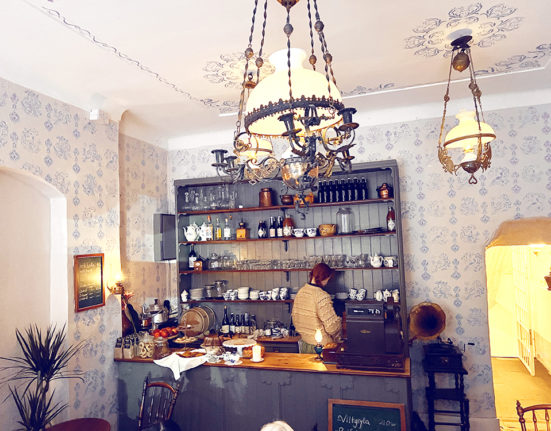Alison Doyle brought a breath of fresh Irish air to Sweden whilst she was here. Her St Patrick’s day parties in Ystad were legendary, with Vatten Teknik in the kommun lighting up the water towers green for the occasion, Irish dancing to the fantastic band, Molly på Rymmen, and just great craic.
But of course, it was also about the gorgeous Irish food; boxty with crispy bacon, loads of brown bread with slices of smoked salmon with a lemony creme fraiche dressing, a huge pot of stew, bacon and cabbage, gur cake, guinness cake and porter cake. So I’m very excited that Alison has decided to share some of her recipes with your living city for March; the month of St Patrick’s Day! Bain taitneamh as!!

These little sweet delights (also known as Chester cakes) take their name from Dublin ‘gurriers’ or young people, supposedly up to no good; to ‘go on the gur’ meant to bunk off school. Since traditional gur cake is made from leftover stale bread, it was one of the cheapest things to buy from the baker, so young lads on the gur would buy pieces of this to fuel their school-skipping activities.
Ingredients:
(Makes around fifty-four 3cm x 3cm squares)
PASTRY:
250g plain flour
125g cold butter, cut into cubes
3 tblsp cold water approx
a little milk to brush on the pastry (optional)
FILLING:
300g stale bread (about 8 slices of regular sized sliced pan)
350ml fresh, strongly brewed tea
150g mixed dried fruit (e.g. sultanas, raisins)
2 tblsp treacle (you can substitute molasses or brown sugar)
2 tblsp golden syrup (you can substitute ljus syrup or brown sugar)
1 tsp ginger
0.25 tsp cinnamon
0.25 tsp cloves
pinch of salt
Optional extras: orange / lemon zest, drop of brandy
You”ll also need:
Rectangular baking tin – 27cm x 18cm and about 4cm deep
Directions
- In a large bowl rub the butter into the flour until the texture resembles coarse meal, but with some larger (approx. pea-sized) lumps of butter remaining.
- Sprinkle over a tablespoon of the cold water, and toss the flour and the water together, not too wet though.
- Squeeze a handful of the mixture – if it sticks together and doesn”t crumble apart, it”s ready.
- If not sprinkle on some more water and repeat.
- Roll the pastry out (ideally between a couple of sheets of baking paper) so that it”s large enough to make a base and lid for your baking tin, then chill for at least 30 minutes.
- Remove the hard crusts from the bread. Place the bread in a medium-sized bowl and pour the tea over it. Allow the tea to soak in and soften for a minute or two, then mash well with a fork (You need just enough liquid to wet all of the bread – the mashed bread mixture will be stiff rather than overly liquidy).
- Stir in fruit, treacle, golden syrup, ginger, cinnamon, cloves and salt. Mix well and leave to plump up for an hour or two.
- Preheat the oven to 200C
- Remove the pastry from the fridge.Use half of it to line the base of your tin (just lining the base and not the sides). Then smooth the filling over the base layer and top with the rest of the pastry.
- Prick the pastry topping all over with a fork, brush with a little milk if you like, and bake until golden, around 30 minutes or so. Allow it to cool in the tin before slicing into squares and eating with a cup of tea.
Want more fantastic recipes? Check out our Expat Cookbook!
Recipe: Alison Doyle
Photo Credit: Cabra History











